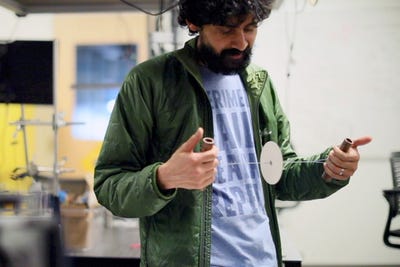How A Classic Toy Inspired A 20-cent Device
January 11, 2017
Using the same mechanical principles that makes a whirligig toy spin, Stanford bioengineers developed human-powered blood centrifuge using just 20 cents of paper, twine, and plastic.
Amanda Pedersen

Manu Prakash, an assistant professor of bioengineering at Stanford, designed a hand-spun centrifuge that could help detect diseases like malaria, HIV, and tuberculosis in poor, off-the-grid regions. The design was inspired by a whirligig toy.
When Manu Prakash visited a rural clinic in Uganda and noticed an expensive centrifuge device being used as a doorstop simply because there was no electricity to run it, he knew there had to be a way to make a human-powered centrifuge device for underserved regions that do not have electricity.
A centrifuge is a device that separates blood components and makes pathogens easier to detect, and the technology is especially important in poor, off-the-grid regions where diseases like malaria, African sleeping sickness, HIV, and tuberculosis are most prevalent.
A typical centrifuge spins fluid samples inside an electric-powered, rotating drum. As the drum spins, centrifugal forces separate fluids by density into layers within a sample tube. In the case of blood, heavy red cells collect at the bottom of the tube, watery plasma floats to the top, and parasites, like those that cause malaria, settle in the middle.
"There are more than a billion people around the world who have no infrastructure, no roads, no electricity," Prakash said. "I realized that if we wanted to solve a critical problem like malaria diagnosis, we needed to design a human-powered centrifuge that costs less than a cup of coffee."
Prakash is the senior author on a study that was published this week in Nature Biomedical Engineering. He is also an assistant professor of bioengineering at Stanford.
According to the test results, the new device achieved rotational speeds up to 125,000 revolutions a minute, and separated blood plasma from red cells in 1.5 minutes, without electricity.
Built from just 20 cents of paper, twine, and plastic, the new device, dubbed a paperfuge, can spin at speeds of 125,000 rpm and exert centrifugal forces of 30,000 Gs.
To design the device, Prakash and Saad Bhamla, a postdoctoral research fellow and first author on the paper, drew inspiration from classic children's toys that spin, such as yo-yos, tops, and whirligigs.
"One night I was playing with a button and string, and out of curiosity, I set up a high-speed camera to see how fast a button whirligig would spin," Bhamla said. "I couldn't believe my eyes."
The whirligig button rotated at 10,000 rpms to 15,000 rpms, he said.
The researchers mounted a capillary of blood on a paper-disc whirligig and was able to centrifuge blood into layers. It was a definitive proof-of-concept, but before he went to the next step in the design process, they first had to study a whirligig to figure out how the toy actually worked.
Bhamla recruited three undergraduate engineering students from MIT and Stanford to build a mathematical model of how devices work. The team created a computer simulation to capture design variables like disc size, string elasticity, and pulling force. They also borrowed equations from the physics of supercoiling DNA strands to understand how hand-forces move from the coiling strings to power the spinning disc.
Next, the researchers were able to create a prototype with rotational speeds of up to 125,000 rpm, a magnitude significantly higher than their first prototypes.
"From a technical spec point of view, we can match centrifuges that cost from $1,000 to $5,000," Prakash said.
The team also tweaked the device's safety and began testing configurations that could be used to test live parasites in the field. From lab-based trials, they found that malaria parasites could be separated from red blood cells in 15 minutes. And by spinning the sample in a capillary pre-coated with acridine orange dye, glowing malaria parasites could be identified by placing the capillary under a microscope.
Prakash and Bhamla are currently running a field validation trial to study the paperfuge for malaria diagnostics with community health collaborators in Madagascar.
Amanda Pedersen is Qmed's news editor. Reach her at [email protected].
[Image credit: Stanford.]
About the Author(s)
You May Also Like

.png?width=300&auto=webp&quality=80&disable=upscale)
